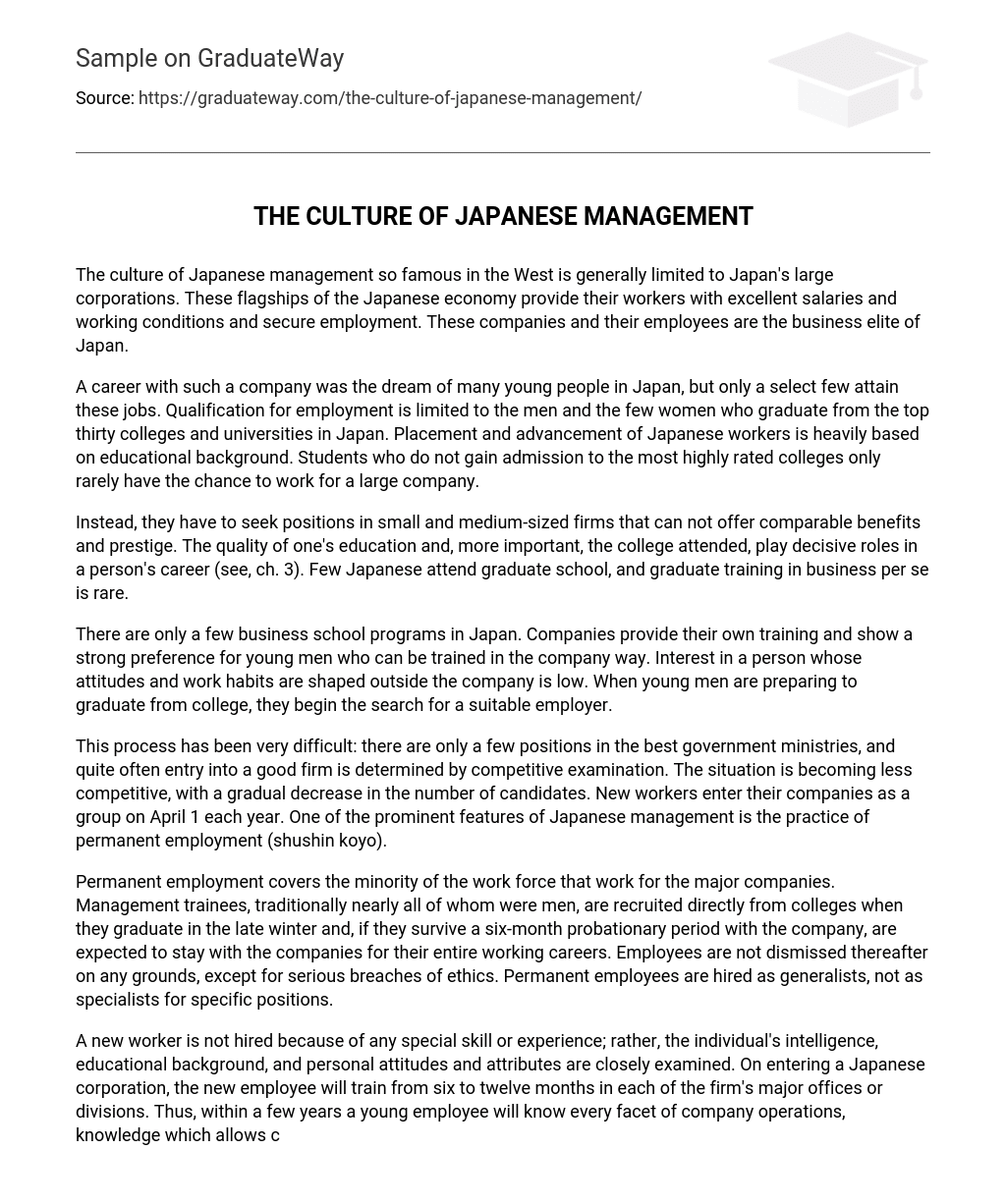The culture of Japanese management so famous in the West is generally limited to Japan’s large corporations. These flagships of the Japanese economy provide their workers with excellent salaries and working conditions and secure employment. These companies and their employees are the business elite of Japan.
A career with such a company was the dream of many young people in Japan, but only a select few attain these jobs. Qualification for employment is limited to the men and the few women who graduate from the top thirty colleges and universities in Japan. Placement and advancement of Japanese workers is heavily based on educational background. Students who do not gain admission to the most highly rated colleges only rarely have the chance to work for a large company.
Instead, they have to seek positions in small and medium-sized firms that can not offer comparable benefits and prestige. The quality of one’s education and, more important, the college attended, play decisive roles in a person’s career (see, ch. 3). Few Japanese attend graduate school, and graduate training in business per se is rare.
There are only a few business school programs in Japan. Companies provide their own training and show a strong preference for young men who can be trained in the company way. Interest in a person whose attitudes and work habits are shaped outside the company is low. When young men are preparing to graduate from college, they begin the search for a suitable employer.
This process has been very difficult: there are only a few positions in the best government ministries, and quite often entry into a good firm is determined by competitive examination. The situation is becoming less competitive, with a gradual decrease in the number of candidates. New workers enter their companies as a group on April 1 each year. One of the prominent features of Japanese management is the practice of permanent employment (shushin koyo).
Permanent employment covers the minority of the work force that work for the major companies. Management trainees, traditionally nearly all of whom were men, are recruited directly from colleges when they graduate in the late winter and, if they survive a six-month probationary period with the company, are expected to stay with the companies for their entire working careers. Employees are not dismissed thereafter on any grounds, except for serious breaches of ethics. Permanent employees are hired as generalists, not as specialists for specific positions.
A new worker is not hired because of any special skill or experience; rather, the individual’s intelligence, educational background, and personal attitudes and attributes are closely examined. On entering a Japanese corporation, the new employee will train from six to twelve months in each of the firm’s major offices or divisions. Thus, within a few years a young employee will know every facet of company operations, knowledge which allows companies to be more productive. Another unique aspect of Japanese management is the system of promotion and reward.
An important criterion is seniority. Seniority is determined by the year an employee’s class enters the company. Career progression is highly predictable, regulated, and automatic. Compensation for young workers is quite low, but they accept low pay with the understanding that their pay will increase in regular increments and be quite high by retirement.
Compensation consists of a wide range of tangible and intangible benefits, including housing assistance, inexpensive vacations, good recreational facilities, and, most important, the availability of low-cost loans for such expenses as housing and a new automobile. Regular pay is often augmented by generous semiannual bonuses. Members of the same graduating class usually start with similar salaries, and salary increases and promotions each year are generally uniform. The purpose is to maintain harmony and avoid stress and jealousy within the group.
Individual evaluation, however, does occur. Early in workers’ careers, by age thirty, distinctions are made in pay and job assignments. During the latter part of workers’ careers, another weeding takes place, as only the best workers are selected for accelerated advancement into upper management. Those employees who fail to advance are forced to retire from the company in their midto -late fifties.
Retirement does not necessarily mean a life of leisure. Poor pension benefits and modest social security means that many people have to continue working after retiring from a career. Many management retirees work for the smaller subsidiaries of the large companies, with another company, or with the large company itself at substantially lower salaries. A few major corporations in the late 1980s were experimenting with variations of permanent employment and automatic promotion.
Some rewarded harder work and higher production with higher raises and more rapid promotions, but most retained the more traditional forms of hiring and advancement. A few companies that experienced serious reverses laid off workers, but such instances were rare. Another aspect of Japanese management is the company union, which most regular company employees are obliged to join. The worker do not have a separate skill identification outside of the company.
Despite federations of unions at the national level, the union does not exist as an entity separate from, or with an adversarial relationship to, the company. The linking of the company with the worker puts severe limits on independent union action, and the worker does not wish to harm the economic wellbeing of the company. Strikes are rare and usually brief. Japanese managerial style and decision making in large companies emphasizes the flow of information and initiative from the bottom up, making top management a facilitator rather than the source of authority, while middle management is both the impetus for and the shaper of policy.
Consensus is stressed as a way of arriving at decisions, and close attention is paid to workers’ well-being. Rather than serve as an important decision maker, the ranking officer of a company has the responsibility of maintaining harmony so that employees can work together. A Japanese chief executive officer is a consensus builder.





